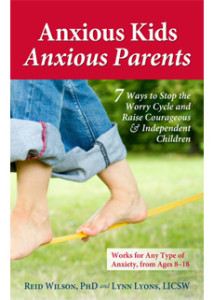The feelings of anxiety are real and physical, similar to what one might feel when encountering a grizzly bear, or another real, physical threat. Our bodies automatically react with the “flight or fight phenomenon.”
The physical sensations we experience with anxiety are:
• rapid heart rate
• fast, shallow breathing
• increase in blood pressure
• stomachache
• dry mouth
• tightened muscles
We react this way because it is more important for our hearts to pump blood to our muscles so that we can fight or run away from the bear than to digest what we had for lunch! It is like pressing the accelerator in the car.*
Of course when we’re relaxed our:
• heart rate is slower
• we breathe slowly and comfortably
• our blood pressure is down
• our muscles are looser
The problem is, our brains and bodies react the same way whether we are encountering a grizzly bear or being nervous before taking a test (text taking anxiety), giving a speech, performance anxiety such as at a musical recital, or competing in a sporting event (sports performance anxiety).
Anxiety has 2 driving forces**
1. The person overestimates the risk or challenge
2. The person underestimates his or her internal strengths and resources.
Anxiety is always future-oriented and involves the question, “What if…” **
What if I:
1. forget my lines?
2. double-fault?
3. miss this shot?
4. get a bad grade on this test?
Mental Imagery & Muscle Memory
Of course, we are all taught about muscle memory, and that it works from the bottom up. Well, it turns out that MENTAL IMAGERY ALSO CAUSES MUSCLE MEMORY! So that when you visualize yourself kicking a soccer ball well, the same areas of the brain are working as when you are actually kicking the soccer ball. And, by visualizing, you can create new neural pathways in the brain, new connections, neuron to neuron, thereby creating muscle memory from the top down. This is called “creating new brain real estate” and is how neuroplasticity works. The brain actually changes itself!
And, this visualization, also known as mental imagery or self-hypnosis, is a skill that needs to be learned and practiced. And, just like any other skill:
• The more you practice, the better you get at it.
• The more you practice, the easier it gets.
• The more you practice, the faster you get at it.
Cognitive Behavioral Therapy (CBT) has been shown to be extremely effective for anxiety of all sorts, and Dr. Lazarus has found that by using a combination of medical hypnosis and CBT, his patients not only learn some extremely powerful tools, but they also have significant improvement after only 1 to 3 visits.
It involves teaching patients to recognize when they have negative thoughts and how these thoughts affect how they feel. Patients then learn how to understand how their cognitive distortions, or irrational thought processes, contribute to their problems and how to talk back to the negative thoughts. And, once they are able to take control in this fashion, their feelings change.
To summarize in one sentence: “When you change the way you think, you change the way you feel.”
This is the cognitive part of CBT.
CBT : Behavioral
The behavioral part involves actually changing one’s behavior. Of course, when we are anxious about doing something, we tend to want to avoid it.
For example, for people who are afraid of flying on an airplane, the easiest thing for them to do is to drive, or take a bus, train, or boat. In order to overcome this fear, eventually they have to get on a plane. This can be done through a series of small, more manageable steps (called desensitization), or it can be done quickly.
The analogy that Dr. Lazarus likes to use is: “When you have to remove a band-aid, do you prefer to do this slowly or quickly?”
With this type of work, called exposure therapy, the slower one goes, the easier it is for the patient, and, of course, the longer it takes. When one goes quickly, it is a lot harder, takes an enormous amount of courage, and the results are a lot faster.
When Dr. Lazarus sees patients, he incorporates not only hypnosis techniques, but also cognitive behavioral techniques.
Where can I find more about Anxiety?
My colleagues, Reid Wilson, PhD and Lynn Lyons, LCSW, are the authors of a new book entitled Anxious Kids, Anxious Parents: 7 Ways to Stop the Worry Cycle and Raise Courageous & Independent Children. It outlines a practical step-by-step approach to help families dealing with anxiety.
Visit Lynn Lyons’ Website for more information
*Personal communication, Pamela Kaiser, PhD, NP
**Personal communication, Michael Yapko, PhD





